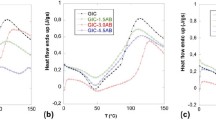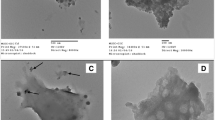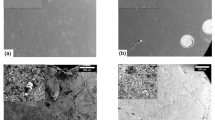Abstract
The set of glass ionomer cement (GIC) is accelerated by application of ultrasound. Although GIC has somewhat displaced zinc polycarboxylate cement (ZPC) in dental applications the latter is still extensively used. Like GIC, it provides direct adhesion to tooth and can provide F release, but is more radiopaque and biocompatible than GIC. The aim of this study is to examine the effect of ultrasound on the setting of ZPC using Fourier transform infra red spectroscopy and any interaction with SnF2 addition. ZPC with and without SnF2 addition (+/−S) at luting (L) 2:1 P/L ratio and restorative (R) 4:1 P/L ratio consistencies. Ultrasound is applied to the cement using Piezon-Master 400, EMS, Switzerland at 60 s from start of mixing for 15 s. The ratios of absorbance peak height at 1,400 cm−1 –COO– to that at 1,630 cm−1 –COOH were measured and compared those obtained for the cement not treated with US. These values were taken at the elapsed time at which no further change in spectrum [ratio] was observed at room temperature [10–20 min]. The US results are taken at 2 or 3 min. No US: R/+S (1.09), R/−S (1.2), L/+S (1.07), L/−S (1.04); US: R/+S (1.50), R/−S (1.64), L/+S (1.38), L/−S (1.05). The results show all four ZPC formulations are very sensitive to ultrasound whether with or without SnF2. Reducing US to 10 s produces lower initial ratios but these increase up to 10 min when very high ratios (>2) are obtained. Previous studies with restorative GICs found that 40–55 s US was needed to produce the effect found with 15 s on ZPCs. ZPC powder is more basic than GIC glass; this may account for ZPC’s greater sensitivity to US. Ultrasound may provide a useful adjunct to the clinical use of ZPC both as luting agent and temporary restorative.







Similar content being viewed by others
References
Towler MR, Bushby AJ, Billington RW, Hill RG. A preliminary comparison of the mechanical properties of chemically cured and ultrasonically cured glass ionomer cements, using nano-indentation techniques. Biomaterials. 2001;11:1401–6.
Talal A, Tanner KE, Billington RW, Pearson GJ. Effect of ultrasound on the setting characteristics of glass ionomer cements studied by Fourier Transform Infra Red Spectroscopy. J Mater Sci Mater Med. 2009;20:405–11.
Kleverlaan CJ, van Duinen, Feilzer AJ. Mechanical properties of glass ionomer cements affected by curing methods. Dent Mater. 2004;1:45–50.
Alger TJ, Kleverlaan CJ, Prahal-Andersen B, Feilzer AJ. The influence of accelerating the setting rate by ultrasound of heat on the bond strength of glass ionomers used as orthodontic bracket cements. Euro J Orthod. 2005;27:1–5.
Foster J, Dovey E. German patent 2301444.
Wilson AD, Groffman DM, Powis DR, Scott RP. An evaluation of the impinging jet method for measuring the erosion of dental cements. Biomaterials. 1986;7:55–60.
Billington RW, Hadley PC, Williams JA, Pearson GJ. Kinetics of fluoride release from zinc oxide-based cements. Biomaterials. 2001;22:2507–13.
Rae J, Ashokummar M, Eulaerts O, von Sonntag C, et al. Estimation of ultrasound induced cavitation bubble temperatures in aqueous solutions. Ultrason Sonochem. 2005;12:325–9.
Mason TJ, Lorimer JP. An introduction to sonochemistry. Endeavour. 1989;13:123–8.
Smith DC. Development of glass-ionomer cement systems. Biomaterials. 1998;19:467–78.
Gregor H. Complexation constants of polyacrylic acid with Mg, Ca, Mn, Co, and Zn. J Phys Chem. 1955;59:990–1.
Bertenshaw BW, Combe EC. Studies on polycarboxylate cements 2. Analysis of powders. J Dent. 1972;1:65–8.
Thanjal NK, Billington RW, Shahid S, Luo J, et al. Kinetics of fluoride ion release from glass ionomer cement: effect of ultrasound, radiant heat and glass composition. J Mater Sci Mater Med. 2010;21:589–95.
Towler MR, Crowley CM, Hill RG. Investigation into the ultrasonic setting of glass ionomer cements. Part I: postulated modalities. J Mater Sci Lett. 2003;22:539.
Author information
Authors and Affiliations
Corresponding author
Rights and permissions
About this article
Cite this article
Shahid, S., Billington, R.W., Hill, R.G. et al. The effect of ultrasound on the setting reaction of zinc polycarboxylate cements. J Mater Sci: Mater Med 21, 2901–2905 (2010). https://doi.org/10.1007/s10856-010-4146-x
Received:
Accepted:
Published:
Issue Date:
DOI: https://doi.org/10.1007/s10856-010-4146-x




